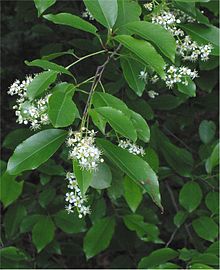| Prunus serotina | |
|---|---|

| |
| Flowers and leaves | |
| Scientific classification | |
| Kingdom: | Plantae |
| Clade: | Tracheophytes |
| Clade: | Angiosperms |
| Clade: | Eudicots |
| Clade: | Rosids |
| Order: | Rosales |
| Family: | Rosaceae |
| Genus: | Prunus |
| Subgenus: | Prunus subg. Padus |
| Species: | P. serotina
|
| Binomial name | |
| Prunus serotina | |

| |
| Natural range | |
| Synonyms[2] | |
| |
Prunus serotina, commonly called black cherry,[3] wild black cherry, rum cherry,[4] or mountain black cherry,[5] is a deciduous tree or shrub[4] in the rose family Rosaceae. Despite being called black cherry, it is not very closely related to the commonly cultivated cherries, such as sweet cherry (P. avium), sour cherry (P. cerasus) and Japanese flowering cherries (P. serrulata, P. speciosa, P. sargentii, P. incisa, etc.), which belong to Prunus subg. Cerasus. Instead, P. serotina belongs to Prunus subg. Padus, a subgenus also including Eurasian bird cherry (P. padus) and chokecherry (P. virginiana).[6][7][8] The species is widespread and common in North America and South America.[9][10][11][12]
Black cherry is closely related to the chokecherry (P. virginiana); chokecherry, however, tends to be shorter (a shrub or small tree) and has smaller, less glossy leaves.
- ^ Stritch, L. (2018). "Prunus serotina". IUCN Red List of Threatened Species. 2018: e.T61957524A61957527. doi:10.2305/IUCN.UK.2018-2.RLTS.T61957524A61957527.en. Retrieved November 19, 2021.
- ^ "Prunus serotina L." Plants of the World Online. Royal Botanic Gardens, Kew. Retrieved March 17, 2024.
- ^ World Economic Plants: A Standard Reference, Second Edition. CRC Press; 19 April 2016. ISBN 978-1-4665-7681-0. p. 833–.
- ^ a b "Prunus serotina". North Carolina Extension Gardener Plant Toolbox. North Carolina State University and North Carolina Agricultural and Technical State University. Archived from the original on July 13, 2024. Retrieved October 17, 2024.
- ^ ""Prunus serotina"". Plant Database. Lady Bird Johnson Wildflower Center at the University of Texas at Austin. Archived from the original on August 26, 2024. Retrieved October 15, 2024.
- ^ Wen, Jun; Berggren, Scott T.; Lee, Chung-Hee; Ickert-Bond, Stefanie; Yi, Ting-Shuang; Yoo, Ki-Oug; Xie, Lei; Shaw, Joey; Potter, Dan (May 18, 2008). "Phylogenetic inferences in Prunus (Rosaceae) using chloroplast ndhF and nuclear ribosomal ITS sequences". Journal of Systematics and Evolution. 46 (3): 322. doi:10.3724/SP.J.1002.2008.08065 (inactive November 1, 2024). ISSN 1674-4918.
{{cite journal}}: CS1 maint: DOI inactive as of November 2024 (link) - ^ Liu, Xiao-Lin; Wen, Jun; Nie, Ze-Long; Johnson, Gabriel; Liang, Zong-Suo; Chang, Zhao-Yang (May 1, 2013). "Polyphyly of the Padus group of Prunus (Rosaceae) and the evolution of biogeographic disjunctions between eastern Asia and eastern North America". Journal of Plant Research. 126 (3): 351–361. Bibcode:2013JPlR..126..351L. doi:10.1007/s10265-012-0535-1. ISSN 1618-0860. PMID 23239308. S2CID 5991106.
- ^ Shi, Shuo; Li, Jinlu; Sun, Jiahui; Yu, Jing; Zhou, Shiliang (2013). "Phylogeny and classification of Prunus sensu lato (Rosaceae)". Journal of Integrative Plant Biology. 55 (11): 1069–1079. doi:10.1111/jipb.12095. ISSN 1744-7909. PMID 23945216.
- ^ Rohrer, Joseph R. (2014). "Prunus serotina". In Flora of North America Editorial Committee (ed.). Flora of North America North of Mexico (FNA). Vol. 9. New York and Oxford: Oxford University Press – via eFloras.org, Missouri Botanical Garden, St. Louis, MO & Harvard University Herbaria, Cambridge, MA.
- ^ "Prunus serotina". County-level distribution map from the North American Plant Atlas (NAPA). Biota of North America Program (BONAP). 2014.
- ^ Morales Quirós, J. F. 2014. Rosaceae. En: Manual de Plantas de Costa Rica. Vol. VII. B.E. Hammel, M.H. Grayum, C. Herrera & N. Zamora (eds.). Monographs in Systematic Botany from the Missouri Botanical Garden 129: 437–463
- ^ Jørgensen, P. M., M. H. Nee & S. G. Beck. (eds.) 2014. Catálogo de las plantas vasculares de Bolivia, Monographs in systematic botany from the Missouri Botanical Garden 127(1–2): i–viii, 1–1744.
